|
FAQs on Pond Repair:
Leaks/Leaking
Related Articles: Pond
Repair Work, Liners for
Ponds,
Related FAQs: Water
Feature Repairs 1, Water Feature Repairs
2, Water Feature Repairs
3, More specifically: Seepage, Earthen
Pond Repairs, Waterfall
Repairs, Electrical
Problems, Fountain Repairs,
Faux Rock Repairs, Crack Repairs... & Foundation Coatings, Liner Pond Repairs, Liners in Pond Construction,
|
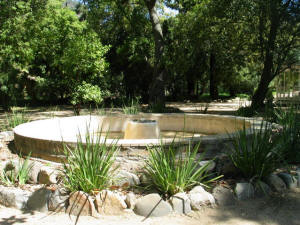
|
 |
Aquatic Gardens
Ponds, Streams, Waterfalls
& Fountains:
Volume 1. Design & Construction
Volume 2. Maintenance, Stocking, Examples
V. 1
Print and
eBook on Amazon
V. 2
Print and
eBook on Amazon
by Robert (Bob) Fenner |
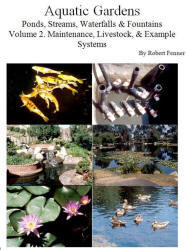 |
Leaking pond (converted metal stock tank)
7/25/18
Hi
I have a nice 750 gal. pond with fountain. It was made by burying an 8 ft.
galvanized metal stock tank 12 inches deep on a 2” sand base over clay, then
camouflaging the sides with concrete pavers. We coated the inside of the stock
tank with two coats of rubberized paint before installing, and then later put in
a concrete fountain and added goldfish. Things have gone well for nearly 15
years; I’ve drained and cleaned it several times. We did not drill any holes
into the tank for any reason.
<Sounds good thus far>
However, last week we drained the pond after a 4 year break. There was a lot of
mud; I had to shovel it out manually, then use a shop vac to get the last of the
wet mud and gunk. Nothing appeared to be wrong or weak, so I refilled the pond
without scrubbing either floor or sides.
<Ok>
Things went well for about a week; the water level stayed at the filled level
with no drop.
Suddenly, 6 days later, the pond has lost about 200 gallons overnight, and
another 100 or so in the hours since I checked. I’ll soon fish out the pet
goldfish into a holding tank until things get stable.
My question; what product or products can I use to stop the leaks in a metal
pond? Would Thoroseal work in this case? What are my options?
<Mmm; not Thoroseal or any of their other fine products as far as I'm aware. You
need/want something that's elastomeric; has a bit of stretch. I see that Liquid
Rubber Waterproof Sealant/Coating has a decent priced 5 gal. size. I would go
the extra expense and buy/use their Seam Tape or GeoTextile at the bottom seam
and vertical joint/s. DO clean the basin as well as you can. SEE and adhere to
WWM's outline on acid/bleach washing to prep. the surface. It MUST be clean and
dry ahead of application>
Thanks for any help you can give me! I just don’t want to hear that I need to
replace the stock pond. I’m in Santa Barbara.
Sue Solomon
<Cheers Sue. Please send along your impressions, perhaps a pic or two of the
project. Bob Fenner>
Re: Leaking pond (converted metal stock tank)
7/26/18
Hi there! Thanks for your quick response!
We seem to be lucky ... the tank leak stopped abruptly at about the 2/3
full level, so not as critical as we thought. I think we're going to
eventually just replace the
stock tank with a new one, or else get a liner to cover the metal tank.
Still negotiating with the hubby on that, although that would be the
quickest and cheapest alternative, if we can't find the hole to patch.
<Mmm; after "being at this" for decades; writing "pond books"; giving
presentations to koi, pond societies for ages, I strongly encourage you
to do the cleaning and repair mentioned previously. IF this stock tank
is leaking to a degree, chances are very good that it will either
continue, or possibly fail entirely>
Thanks again for your suggestions.
Sue Solomon
<Certainly welcome. Bob Fenner>
|
Pond repair question 5/21/15
Hi Bob,
<Wendell>
I recently bought a property in northern Vermont, neglected for many years, with
a large (1/2 acre or about 20,000 sf) bitumen asphalt pond.
<Oooh, olde school>
The pond should be around 7' deep but has a leak at roughly 4'6". There is a
drain valve in a manhole which I tested and works fine. My plan was to drain the
pond, either fully and muck it out,
<How?>
or enough to expose the leak cracks and then fill and seal them.
<With...?>
I am reluctant to fully drain it at the moment as there are many frogs and
salamanders breeding - and I think one snapping turtle which I'd like to get rid
of.
<Yes; I would>
There are many cracks around the sloped edge with organic material growing out
of them. Fortunately, a metal snow shovel seems to clear off most of it.
<I'd consider making a shotcrete (and color) berm... with anchored pencil rod
re-bar and mesh (chicken wire likely)>
What would you recommend patching it with?
<Maybe more asphalt emulsion... Henry's or such... But... really... best
to have the soil tested... IF you want a more permanent improvement...
See WWM re liners...>
My thought was to gouge out the cracks and fill with either hydro-cement or
asphalt/bitumen.
<Worth trying>
Is there a plastic or polymer solution to this?
<Not as far as I know; no>
During Feb/Mar, I measured the surface ice to be 16"+, so freeze/thaw is another
problem.
<Yes... a few approaches to this as well... the slope and berm...>
See pics attached...
Many thanks,
Wendell Anderson
<Let's keep chatting till you're aware of your choices here. Bob Fenner>
|
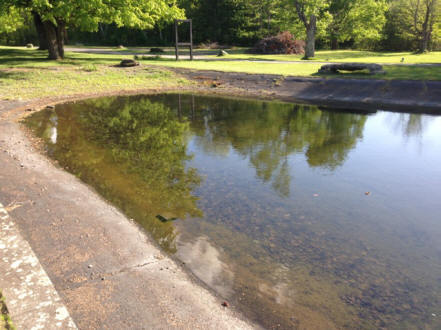
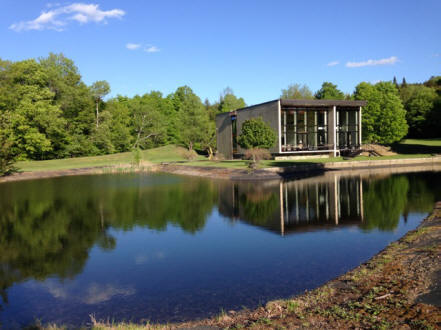
|
|
Re: Pond repair question
5/21/15
Hi Bob,
Thank you. See below.
<Uhhh; a mess for others to read through>
> Subject: Pond repair question
> Hi Bob,
> <Wendell>
> I recently bought a property in northern Vermont, neglected for many years,
> with a large (1/2 acre or about 20,000 sf) bitumen asphalt pond.
> <Oooh, olde school>
> The pond should be around 7' deep but has a leak at roughly 4'6". There is
> a drain valve in a manhole which I tested and works fine. My plan was to
> drain the pond, either fully and muck it out,
> <How?> {was thinking to drain it fully and rake/shovel it out)
<<DO look into buying or renting a trash-pump... diaphragm type if there's much
in the way of larger solids... And I suspect there will be further damage from
entering the pond>>
> or enough to expose the leak cracks and then fill and seal them.
> <With...?>(Thoroseal WaterPlug in cracks, cover in Thoroseal or bitumen
driveway sealer, Henry's roof sealer?)
<<NEED to know if the damaged area is expansive... i.e. if it's moving
at all. If so the Thoro products won't work; nor asphaltous material if much
wet, flexible.... might try a patch... of roofing material AND the Henry's...
will require a few dry days to dry the pond, dry the repair>>
> I am reluctant to fully drain it at the moment as there are many frogs and
> salamanders breeding - and I think one snapping turtle which I'd like to
> get rid of.
> <Yes; I would>
> There are many cracks around the sloped edge with organic material growing
> out of them. Fortunately, a metal snow shovel seems to clear off most of
it.
> <I'd consider making a shotcrete (and color) berm... with anchored pencil
> rod re-bar and mesh (chicken wire likely)>(I think this will be Plan B -
assume you mean just the top edge to below present waterline where leak is, will
it adhere to the underwater area after draining enough to expose and dry it) (I
walked it and there is roughly 500' of perimeter x 6'-8' of exposed berm, about
30" in elevation depth)
<<Yes to over the existing edge throughout>>
> What would you recommend patching it with?
> <Maybe more asphalt emulsion... Henry's or such... But... really... best to
> have the soil tested... IF you want a more permanent improvement... See WWM
> re liners...>(I assume a 1/2 acre liner would be most costly? - Plan C
perhaps)
<<I'd count on a half dollar to a dollar a square foot... for the whole
project... IF the soil can be mixed w/ an impervious clay... might hold, be
cheap>>
> My thought was to gouge out the cracks and fill with either hydro-cement or
> asphalt/bitumen.
> <Worth trying>(Plan A, as above with ThoroSeal plug)
> Is there a plastic or polymer solution to this?
> <Not as far as I know; no>
> During Feb/Mar, I measured the surface ice to be 16"+, so freeze/thaw is
> another problem.
> <Yes... a few approaches to this as well... the slope and berm...>
> See pics attached...
> Many thanks,
> Wendell Anderson
> <Let's keep chatting till you're aware of your choices here. Bob
Fenner>(Thanks again...)
<<Cheers, BobF>>
|
Spring fed water feature 4/4/15
Hello, I've been looking everywhere online and your web sight seems to have the
most diverse information and consequent knowledgeable replies that my help me
with my unique situation. The following is a description of my water feature.
<Let's have it!>
I live in a hilly wooded area with natural springs popping out in every ravine.
The original homeowner dammed the ravine nearest and about 30 feet higher in
elevation than the house and ran a 1.5" pipe from the pond behind the dam to a
waterfall and small brook he built on the back of the house.
The waterfall is 5' tall and 4' wide. It fills a small 2 foot wide "L" shaped
pond 1' deep, the short leg of the "L" is in front of the waterfall and the
long leg is 8'. The flow out of the "L" shaped pond overflows to a 2' wide
shallow brook that continues 30' flowing gently down hill back into the ravine.
These features were all constructed with natural stone laid in concrete.
<No liner underneath....>
The waterfall and the brook sides are built with rounded stones and the pond and
brook floors were built with flagstone. This was all built in the 1970's.
The last 2 years I've experienced severe frost heave on posts supporting
an outdoor bar I built 15 years ago that is beside the water feature.
<Ohh...>
With it being spring feed, running continuously year round a leak is not obvious
and being in place for over 40 years there is a tremendous amount of calcified
growth, especially on the waterfall. I'm planning to install a French drain
between the bar and the water feature to control the spring leakage. Ideally I'd
like to install a liner but that's not practical. So I've diverted the spring
flow away from the waterfall and brook and I'm jack-hammering off the calcified
waterfall growth to get back to the original stone. After that I'll start
looking for leaks.
<Mmm; not likely productive>
With all the above background information what will be the best method to seal
the leaks and realizing that I'll never be leak free do you think the French
drain concept will interrupt the sub-surface water movement to eliminate the bar
structure post supports from frost heaving.
Thanks
Jeff Dieterle
Northern Indiana
<Thank you for writing; and your kind initial words. The leakage can really only
be addressed in a permanent way by applying the liner.... As you'll see it is
VERY hard to locate leaks about rock/concrete... and even small joints twixt
them can result in huge seepage of water. I do think your diversion of water and
removal of calcification is worthwhile... but almost
assuredly you'll have to lay in a liner anew a replacement feature (rather than
using the existing), as the current is not likely to lend itself to
modification. Bob Fenner>
Re: Spring fed water feature
4/6/15
Thanks for the quick reply. There is no liner behind the waterfall or under
the brook and I realize that a liner the only way to stop leakage.
<Yes; the only assured way>
I'm not sure how I would rebuild the waterfall with the
liner behind it and replicate the original design.
<Won't be original... if possible, practical, building over the existing, using
it as part of the structural trough is the route to go... extending the liner as
the stream>
I'm still jack-hammering the overgrowth but it appears that
a single vertical row of rounded stone was laid with
concrete (instead of mortar) and tight against the block
wall behind the waterfall.
<Very typical in time failing. Bob Fenner>
|
Small Koi pond; leaking, reading
2/16/15
Hello!
<IM>
Not sure if this is the right spot but we recently converted a old
planter into a fountain. It's made of brick and concrete and there are
some small leaks. Looks like the water is seeping through the concrete
seems.
<Yes>
The inside has elastomeric waterproof undersealent. We don't know what
to use to fill the cracks to stop leak.
<There are a few options to try... Read here:
http://wetwebmedia.com/PondSubWebIndex/LeakRepF.htm
and the linked files above. Bob Fenner> |
.JPG)
.JPG) |
Leaking Pond /Darrel (!)
Dear Bob,
A year ago I corresponded with you (and appreciated your helpful
answers!)
about building a pond. I followed your advise and hired somebody to do
the mixing of concrete. He used a bit of concrete on the walls over
chicken wire, but then covered the bottom and walls of the pond with
Multiset modified thin-set mortar for floor and wall tiles (by Custom
Building Products company).
The pond is slowly leaking and I believe that water permeates the mortar
as it is probably not designed for continuous exposure to water and
under pressure to boot. I can see a wet strip of mortar above the water
line where the water presumably seeps in by capillary action. Is there
anything I could do to make the surfaced waterproof? Preferably
cover/paint it with something rather than using unit for which I would
need special equipment.
I would prefer to do it myself as I do not trust the guy who did it
anymore. (In addition to the leakage, there are other reasons for not
dealing with him anymore.)
Many thanks for your advise...I certainly hope you can come up with some
do-able solution. Best wishes, Zuzana
<Hi Zuzana>
<I'm not Bob so I left your email specifically for him -- but I HAVE had
a leaky pond, so I thought I'd jump in {pun intended!}>
<I've built a number of ponds over the years and I've encountered many
others in various forms of disrepair and I'm vary familiar with
concrete-over-chicken-wire construction and the leaks that come along
with that.>
<After you drain the pond you have to do a close inspection of the
entire pond for structural problems. What I'm saying is that no coating
that you're going to apply without special equipment is going to fill
large gaps or fill any gaps that flex or expand. If you have any
structural problems or cracks they have to be fixed the old-fashioned
way, which is to say grinding them out and using a good quality cement
(like Quick-Crete sold at building supply stores) to get a proper
structure.>
<In connection with that you have to prepare the surface for whatever
coating you're planning to use. This usually involves a scrub with
diluted muriatic acid to clean and etch the surface. No special
equipment, but it's messy and stinky and you need to rig up some
ventilation because you don't want to breath the fumes.>
<Just link in painting ... preparation is everything. The more time you
spend in preparation the more time you'll spend ENJOYING your pond
rather than draining and repairing it. What I mean is... when you think
you have the surface prepped perfectly... work on it some more.>
<Now this brings us to the faith-based portion of the job. I have heard
for years about a wonderful product called Thoroseal and I've heard many
a professional pond builder rave about it. It's never worked very well
for me. I've used a gray Thoroseal paint to seal a concrete waterfall
and it seemed to work fine and lasted about 5 years.>
<What I used - and I'm only giving you my opinion {worth every penny
you're paying for it} is Nelsonite PoolPoxy. If you use PoolPoxy2 you'll
have a durable finish that will last 10 years. If you use PoolPoxy
Hi-build over Nelsonite Primer the people who buy the house after the
people you sell it to will probably have to pay someone to break it up &
haul it away>
<If you go this way - or even go the Thoroseal way - follow the
manufacturer's instructions to the letter & in the slightest question
contact them for clarification. I'm sure Bob will agree that when it
comes to most complaints about coatings, most include "well, I skipped
that step and I short cut on this other step...">
<Best of luck - Darrel>
Leaking pond /RMF
Dear Bob,
A year ago I corresponded with you (and appreciated your helpful
answers!) about building a pond. I followed your advise and hired
somebody to do the mixing of concrete. He used a bit of concrete on the
walls over chicken wire, but then covered the bottom and walls of the
pond with Multiset modified thin-set mortar for floor and wall tiles (by
Custom Building Products company).
<Sounds good thus far; but; where's the liner here?>
The pond is slowly leaking and I believe that water permeates the mortar
as it is probably not designed for continuous exposure to water and
under pressure to boot. I can see a wet strip of mortar above the water
line where the water presumably seeps in by capillary action. Is there
anything I could do to make the surfaced waterproof?
<Yes; will necessitate emptying, cleaning, likely acid/bleach washing
and drying the basin first>
Preferably cover/paint it with something rather than using unit for
which I would need special equipment. I would prefer to do it myself as
I do not trust the guy who did it anymore. (In addition to the leakage,
there are other reasons for not dealing with him anymore.)
Many thanks for your advise...I certainly hope you can come up with some
do-able solution. Best wishes, Zuzana
<Please read here:
http://wetwebmedia.com/PondSubWebIndex/Pond%20Sub%20Web.htm
scroll down to Water Feature Repairs. Bob Fenner>
Waterfall. Help! Common construction error leak
2/23/13
Dear Bob,
We have a beautiful unfinished waterfall that leaks the rocks at the
bottom of the falls are so large that we didn't put a liner underneath.
<Should have put over then... all the way into the basin...>
We used a pool stop leak mortar
<Won't work>
to seal the rocks and the upper liner to the main fall rock. We are in New
England and the mortar cracked in no time. Now we have a quote from some
contractors to help us finish the falls and they recommend moving the
big two fall rocks with a tractor which could take a whole day they are
so large. Also it was very hard to position them even with heavy
machinery the first time. On the end we would still have three liners.
One for the upper falls, one for the lower and one for the pond.
<These need to overlap, be solvented (above water)... together...>
This seems like a very difficult and expensive proposition especially
considering I am great with masonry and we don't have the money to do
this.
Help! Is there a mortar we could use that would at least last several
years?
<None... the "moving" of rock, mortar will cause the latter to crack>
We have seen other mortared waterfalls I the area but not sure how they
were built. Thank you!
Liz Coello in Connecticut
<Do read here (again?):
http://www.wetwebmedia.com/PondSubWebIndex/h2ofallconstr.htm
and the linked FAQs files above... I would lay a liner on top of the
"waterfall trough" and put wire mesh, mortar over this... with the
discharge pipe of the fall dumping water into the liner/trough, and the
liner extending (drain the pond down a foot or so to do this) into the
basin/pond. Understanzee? Bob Fenner>
|
Rock Pond Repair 8/1/12
Sir/ Madam
I have a 5 meter long, 1 meter wide , odd shaped rock pond.
It had been empty for many years but I would like to repair it and get
it up and running again. It is made of many large volcanic rocks which
are joined with concrete and has a concrete floor, which had been calked
over some years ago.
<An apt description of what I see in your pic>
Recently I filled it with water and saw there was a slow leak,
<Yes; very common w/ these sorts of rock ponds, or any rock that
penetrates the edge/wall>
I would think caused by small cracks from an earthquake or plant root
damage.
<Yes; there's always settling... even if the rock is set on, originates
on the original grade>
I have called a professional and they offered me a quote of 7,500
USD to repair and set up lights, filters etc. As I plan on keeping
just a few goldfish and listening to the small waterfall then this price
is out of the question. My enquiry is , what do you think is the best
way to repair it cheaply...can I cover the rock, cement, old calking
with a rubber paint.
<... a few approaches to consider... An elastomeric paint of reasonable
color the cheapest route to go... need to clean the surface, or
resurface... w/ a good mortar... and follow directions for application
explicitly... All the way to the most sure repair, installing a liner...
These are covered by reading here:
http://www.wetwebmedia.com/PondSubWebIndex/Pond%20Sub%20Web.htm
scroll down to the Repairs tray and read>
I tried taking out the calking but this also was difficult.
<Yes>
Could I fibreglass over the old rock, concrete and calking .
<You could... a mess, and not really a long-term repair. Will fail w/in
years>
I would really like to have the pond and small waterfall running but have
a budget of only a few hundred dollars .
<Then not glass and resin>
( Any cheap option is ok, even if I had to do the repair again
after a few years )
A professional here in Japan is just simply out of my financial range.
Hope you can help...Regards
Jonathan Garvey, Kyoto Japan
<Read and write back for clarification. Bob Fenner>
|
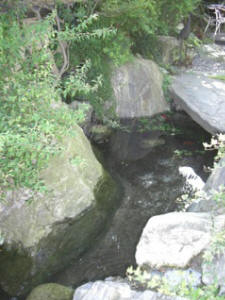 |
|
Re: THANKS, pond repair in Japan 8/2/12
Dear Bob Fenner,
<Jonni>
Thank you so much for taking the time to respond to my enquiry.
Unfortunately, here in Japan there is not much information and even
fewer supplies for ponds...Nobody has a garden let alone a pond!
<In places... not "in large towns". I grew up there in Kyushu>
So I am very grateful for your suggestions.
I shall try to have it re-mortared, and to get some elastomeric
paint...also not available here but I think somebody might ship from the
US.
<Maybe; worth asking>
Once again Thanks ...and I shall let you know how it goes along
<Thank you>
PS the liner is not really a suitable option as ; the pond is odd
shaped, has a bridge over it , and an overflow pipe right in the middle
under the bridge
<The liners are flexible and cut-able in place... but I do understand.
Cheers, BobF>
|
Leak in concrete fish pond 6/26/12
My concrete Koi pond is 50 years old. It is brick on the outside and
concrete on the inside. It is about 1/2 in the ground and 1/2 above
ground level. The inside dimensions are 12 ft. From side to side, 5 ft,
from front to back, 26 in. deep and is built with back a part of a brick
wall. There is a hole drilled through the pond and brick wall,
through which the hose pumps the water into a UV filter. The
filter then sends water through another hose which directs the water
through a lion's head on the wall and spills back into the pond.
The hose that goes from the pump through the wall and to the filter is
3/4 inches and I need more water flow.
<Best to drill/rotohammer this out now... ahead of the leak repair...
such tools, bits of size can be rented from various places>
The hole is, also, in the corner of the pond and touches the side of the
pool. It is almost impossible to seal the hose on that side of the hose.
<Best to abandon, replace at this point/juncture>
I would like to fill that hole
<See WWM re "Water Plug" by Thoro Products>
and make another hole further from the wall and use 1 1/4 in. pipe to
which I would attach 1 1/4 in. hose. The hose through the wall has
flexibility which I think might create leaks and the 1 1/4 pipe would be
rigid.
Will I be able the fill the present hole? And, if so, what product would
I use?
<Please read here:
http://www.wetwebmedia.com/PondSubWebIndex/LeakRepF.htm
and the linked files above. Bob Fenner>
Nancy
pond leakage 3/11/12
Hello crew @ wet web media,
<Hiya - Darrel here>
I have a recurring problem in my Koi pond and maybe you can give me the
best route to fix this. I live in the northeast and have a Koi pond
that the previous owner had constructed out of cement, due to the
freezing issues in my area I have developed cracks in the pond that
seem to be leaking water
<I feel your pain>
I would like to make a permanent fix and am thinking of putting in a
pond liner.
<Sometimes I consider a more permanent fix would be filling it in
with dirt and building a storage shed over mine>
My question to you is - can I put a liner in over a concrete pond?
<Absolutely!>
Will the liner hold the water back from leaking between the liner and
the cement?
<YES!>
How do you attach the liner to the cement?
<Well, Gravity attaches the pond liner. In other words the weight of
the water will keep the liner down. You have two challenges, both
easily addressed.>
<The first is the shape of the liner. As you lay the liner into the
empty pond, you'll find that the EPDM pond liner will conform to
every shape under the sun … except your shape. You will at first find
folds, creases and flaps that are maddening. With the right amount of
tugging, folding and complaining, you will eventually wrestle the liner
into decent position and they sell a special double faced tape for
seaming that also can be used to hold a flap down tight against the
bottom. It's really hard to explain, Karl. It's not a HARD job
… meaning it's not complicated, but it's challenging. The
best I can say is AFTER you've done it you'll think "OK,
that wasn't so hard after all" but DURING the project,
you'll be tempted to think many unkind thoughts.>
<The second challenge is the edges. In NEW pond construction, you
just lay the extra liner up the sides and over the edges and then build
an edge guard over the liner (like a ring of rocks, etc.) and then just
cut away the excess liner. Since your pond already has an edge, my
first suggestion is that you dig a trench around the edge of the
concrete so that you can fold the liner OVER the concrete edge, down
into the soil and then bury it. If your pond already has an edge trim
and you need to run the liner up to the edge and just cut it an inch or
so about the water line, THEN you'll need some EPDM adhesive to
glue the edge of the liner to the properly prepared and sanded concrete
edge.>
Any answers you give me will be greatly appreciated
Sincerely
Karl
<Well, Karl. Those are the answers. I may have made it sound
ominous, but in the overall scheme of things it's really
not.>
leaking pond 10/6/11
We just had a 30 foot long waterfall/fountain installed that has an
8x7x2 foot retention pond. The pond will not hold water. The
recirculation pipe in the bottom does not seem to be the source of the
leak.
<Mmm, have you plugged and pressure tested the related plumbing yet?
This is the first area to investigate. Your installer or any licensed
plumber will know how to, have the tools to do this>
It appears as if there are various very fine holes in this poured
concrete pond wall areas. The contractor has hydraulic cemented the
area and used the product Thoroseal, applying two layers.
<I am a big fan of this and most other Thoro products>
Water appears to still be leaching in from these various fine holes as
the Thoroseal on these areas does not dry.
<? Was this surface cured thoroughly before the basin/s were filled?
DO read on Thoro's site re application: http://www.thoroproducts.com/products_waterproofing.htm>
What would you recommend as the next step to create a leak free
pond?
Thank you!
Carol Galant
<Mmm... there are a few approaches. Best to have you read here:
http://wetwebmedia.com/PondSubWebIndex/LeakRepF.htm
and the linked files above... while you're having the plumbing
tested. IF the concrete and ThoroSeal have been applied properly, they
are not likely the source of leaking.... other "through-put"
items... like the plumbing, rock work... more likely. Bob Fenner>
Re: leaking pond 10/6.5/11
Thank you for responding so quickly. The first thing my installer did
was to check the plumbing and pressure test the lines.
Both of these did not have a problem.
<Rats!>
Yesterday, the installer again used hydraulic cement on the seeping
holes, about 7 of them, added "Fix-A-Leak" and ran the pump
all night.
The level has dropped about 2 inches over 20 hours.
<Too much...>
There is no "rock work" that water can leak through. The pond
is completely cemented.
Decorative rock has been cemented to the top edges but the water line
is 5 inches below that edge.
<Understood... it's the basin itself that is leaking... Oh, how
I wish, and I bet you too, that the install had a waterproof
membrane>
I am thinking a rubber liner of some sort is the next step.
<Mmm, yes...>
But, with the rock already being cemented to the edge, I am wondering
if the use of the EPDM liquid rubber paint on liner would be the next
step.
<Maybe; though I dearly wish I had all the money thrown away on
these applications that did no good. If it were me/mine, I'd try
another coat of Thoroseal ahead of treating the existing work as a hole
in the ground (installing a liner) OR another sealant>
Thanks again!
Carol Galant
<Welcome. BobF>
Leaking Mountain stone Koi pond 11/13/10
Hello,
We have a Koi pond built in 1929 that is constructed of mountain stone
with cement mortar . It has 3 upright planters constructed of Mountain
stone to protect the plants. We are having a leaking problem due to
damage from a storm that dropped a tree limb into it that appears to
have dislodged some of the stone work. We can see no cracks but the
water level is going down.
We have been advised that we must remove all the stone work and replace
it with a liner.
<This is... the most-assured repair. Patching, applying
"sealants" are very doubtful to effect a lasting
repair>
I hate to do this as the pond is really quite lovely to look at. It is
12 feet in diameter and about 1 1/2 ft deep. Do you have any
suggestions?
<To take care when taking apart; take your time... perhaps some
photos, labels to assist in reassembling>
Any help you might give would be greatly appreciated. I just found you
site and it is wonderful. Thanks so much for taking the time to read
this.
<Mmm, you likely have read here:
http://wetwebmedia.com/PondSubWebIndex/linerspdconst.htm
and the linked files above. Bob Fenner>
|
Re: 50 year old concrete goldfish and
Koi pond - 8 months later 8/15/11
Good morning, Bob. Long time no talky to. I hope all is well with
you.
<Yes. Thank you Shirley>
So, here I am a year later from when I first began my pond re-do
journey. To update, in a nutshell - all is excellent! I used
Thoroseal on the new concrete (inside the pond). That was a chore
because the outdoor temperature needed to be 60º for
optimum results, and it was a rainy and chilly November in
Oregon. So I built an insulated "tent" over the pond
and installed a heater and fan inside. I did all the work inside
this cave, over a two week span, in the middle of winter. I was
ever so mindful of following the Thoroseal directions to the
proverbial T. I even messaged with the TS people to be sure I was
doing the best I could under the wintery circumstances. The end
of the TS story - I love Thoroseal! I have read other
posters' comments about TS (some not so complimentary) but it
worked perfect for me - but it is soooo important to NOT be in a
hurry, and to follow the directions explicitly with no fudging on
any steps.
<Ah yes>
So now, jump forward. Pond is full. 55-gallon bio filter and
55-gallon settling chamber is installed and working perfectly. My
semi-gravity bottom drain works marvelously. I'm using a 1200
gph Mag-drive pump submersed in the settling chamber, which draws
water through from the bottom drain in the pond; this water is
pumped into the bottom of the bio filter, and then overflows back
into the 1100 gallon pond. My home-made skimmer is a life-saver.
I bought my first new Koi last weekend after waiting all summer
for the sunlight to propagate the good bacteria/algae so that the
pond would finally clear (with no chemicals or UV light). I am
now ready to "finish" the rather unsightly top and
outside portion of the pond (see attached photo).
<Vey nice covers>
I will be using either slate or quartzite 12" x 12" x
1/2" tiles for the (horizontal) top - each tile to be custom
cut into mitered wedges to fit the contours of the irregularly
shaped pond. Sounds daunting but I did a trial run with paper and
it's easier than I anticipated to create the templates for
each tile (I'll need a tile saw, of course). After the tiles
are mortared into place, I will be adhering 4"-6"
travertine chair rail pieces around the outside top perimeter
along the edge of the tile, and then grouting all. And then I
plan to use a color-tinted stucco for the outside vertical wall.
A lot of work, but do-able, and I think it will be lovely. So,
why email you, you ask....
What should I use for the mortar to affix the slate tile to the
top, and the grout (1/4" grout lines)? Rain, of course, will
be running off of this capstone and into the pond. It was
suggested I use a multi-purpose mortar/grout - and if I did,
could I use an acrylic additive as the wetting agent to make the
mortar more stable/harder/better adhering/safer for fish?
<Yes to these>
Can I use plastic cement (if I can find it) for mortar and grout?
What would you suggest?
<I would use the multi-purpose... mixed w/ a blending bar,
attached to a variable speed drill... in batches... with the
additive>
Oh, and then there is the final landscaping.
I love my 50 year old concrete pond! I love my bio filter and
settling chamber design. It is practically maintenance free, and
the fish are thriving.
<Good>
Thank you for all your previous help. I hope you have had a
marvelous summer!
Shirley in Oregon.
<Thank you; BobF about done in Maine>
ps. The image you uploaded onto your web page, that I sent you of
my filter design, is kind of hard to make out - somehow there are
two images there, one on top of the other, making it hard to tell
what is what. Just thought I would mention it in case somebody
wanted to consider a similar design for their project.
|
|
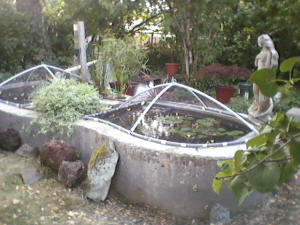
|
Leaking concrete pond 9/30/09
I just found your website and have a question. We have a very large
pond that originally was a swimming pool - concrete and rebar. It has
numerous cracks now and only holds water to a low level. We're
right on the water table - living on a bayou in Florida. A pool place
suggested rather than empty it and reconcrete, etc at great expense, we
should create algae which should seal the cracks. He advised us to add
nitrogen and phosphate and fill the pond in order to grow algae and
thereby plug up the leaks.
<Mmm, no... Too likely to have ongoing REAL problems with excess
algae... insect vectors even as a consequence of so much algal
proliferation>
Is this a good solution to the problem?
<Not IMO/E>
Will these chemicals harm my water lilies, fish and other plants?
<Can, yes>
It sounds good to me but I'm hesitant without some feedback. Any
info you can provide will be GREATLY appreciated. Thanks in advance.
Kathy Gresko in Florida.
<The least expensive, most sure repair/solution is to place an
adequate liner over the existing structure/basin. Please read here
re:
http://wetwebmedia.com/PondSubWebIndex/conclnrconstpd.htm
and here:
http://wetwebmedia.com/PondSubWebIndex/poolpdconvart.htm
and the linked files above. Bob Fenner>
Repairing & refilling Koi pond 8/20/09
Hello Crew!
<Mark>
I desperately need some help, suggestions & answers re: repairing
& re-installing a Koi pond. After a frustrating search for the
source of the leak(s), we have faced the conclusion that the pond will
need to be re-lined rather than repaired. Here are the basic facts:
. in-ground, rubber liner, about 1600 - 1800 gal, about 7 y/o.
. using an exterior biofilter from Tetra which has never been back
flushed; pump to biofilter more than adequate for turnover of water,
about 2000gph
. water quality is clear, algae-free, water chemistry is good (ph,
nitrate, 02 etc.)
. currently stocked w/5 Koi (9" - 16") + 3 baby Koi
<4", + 1 comet (6").
All are healthy, vigorous, beautiful!
. planted w/Anacharis, water lettuce, water hyacinth.
This pond is also contiguous to a "bog" area, rubber-lined
& separated from main pond by rocks, planted w/thriving iris,
pickerel weed, arrowhead etc.
The main pond has been losing about 6" water daily & have been
re-filling w/garden hose every 48hrs or so.
Currently in the NYC area, the weather is very hot, 90+ w/no real end
in sight to the heat wave. It's also been raining often &
heavily, so between the heat & the rain, it's been hard to be
able to get at the pond. We've tried unsuccessfully to identify the
leaks, so are now planning to dismantle the pond, re-line & return
the fish, plants etc.
The dog work of removal of rocks, plants etc. will be daunting, but we
are willing to do this ourselves. The tricky questions are about how to
"warehouse" the fish & how to re-store quality to the
pond water.
<Big "wading pool">
Due to budgetary concerns, we are definitely going to have to improvise
how to hold the fish & do all the work ourselves.
1. How to store the fish safely? In 55gal plastic garbage barrels?
<Nah>
Small (450g) wading pool?
<Much better>
Water would come from pond, itself.
2. What kind of aeration system will we need to keep oxygen levels in
water? What kinds of pumps, airstones etc.?
<Best to use what you have currently...>
3. How to keep water temp low enough? Shade w/patio umbrella? Floating
plants? Bags of ice?
<All the above>
4. How long could the fish survive in this environment?
<Easily a week or two>
5. What are the best ways to re-store pond water quality?
<Return the stored water and filter sans cleaning>
How long would it take before it's safe to return fish to their
pond?
<... immediately. Add some water conditioner for the remaining 1k or
so gallons you're adding new>>
There'll be some microbial benefit from returning water that the
fish have been kept in, also from plants, running the biofilter &
pumps. What about adding commercially available de-chlorinators,
microbe-lift chemicals? Suggestions for brand names?
<Kordon/Novaqua or API equivalent... Microbe-Lift's products are
very good>
6. Am I crazy to even think about trying this myself?
<Not crazy at all. Just need some strong help to lay down/over the
new liner (Oh, and do take care when stepping inside the current one...
treacherously slippery>
The pond, the fish, the plants, the water have been a labor of love
& a are great source of pleasure. The pond was made by myself &
another friend, ourselves. We made all the classic beginning mistakes,
but the pond has been thriving & flourishing. I bought the fish
when they were small at a local aquarium shop & they have grown
into beautiful beautiful creatures.
I would hate to lose any of them.
<Should do fine... just take your time>
After an internet search, I was very happy to have found your site,
it's the most helpful & knowledgeable of any I've read. I
hope to hear from you soon.
Thank you for your time & consideration.
-- Mark Harada --
<Glad to help. Bob Fenner>
Re: repairing & refilling Koi pond 8/20/09
Wow, thank you so much for answering so quickly & in such
detail!
Feeling much better about the whole thing, now. My main fear was that
we'd end up poaching the fish!
<Not to worry>
The only thing I'm not clear about is your suggestion to use the
same pump that we use for the pond for the kids' wading pool.
Won't it be too strong for a much smaller volume of water?
Thanks, again,
-- Mark --
<Will not be too strong, I assure you. BobF>
Koi pond, leak... 1/10/09 Hi, <Dawn> Your
site has been of great help during the construction of our first pond.
I have run into a problem that is not really addressed any where so
your help would be wonderful.. We have built a Koi pond for a client in
the Virgin Islands. It is about 900 gallons and is concrete, the seal
is Thoroseal with a grey green dye. The pond has an Island in the
middle on which sits a large rock 3'x4'x2'. A pipe is run
through the rock <Mmm, no liner I take it... and this pipe somehow
has water about it... either from the fall or penetrating the
basin?> to the top and then through a copper bowl. A slow fountain
pump fills the bowl with water which then spills over the rim of the
bowl and down the sides of the rock. It was decided to raise the water
level about two inches above the joint between the rock and the
concrete pond. <Ohhh, likely leaking> We have begun experiencing
a leak which stops as that joint is reached. Since the leak is about
1/2" in a 24 hour period and since the owner would really like the
water level to stay the two inches up the rock we are wondering about
sealing the rock in two areas. <Mmmm> 1.) To solve any leaking at
the joint which we suspect is the major problem (due to normal
expansion and contraction of the rock:) put a two inch silicone bead at
the joint (however I see on your site that silicone may not seal a
joint between rock and concrete) or put a two inch collar of epoxy
grout which should seal to both the rock and cement with no problems.
Finally the last choice would be to build a cement and ThoroSealed
collar over the joint extending just above the desired water level
<Mmm, none of these is likely to be effective... Thoro has other
products> And if we fix the first problem but still have water loss
then we would proceed to fix #2. 2.) To solve the problem of both
excessive evaporation from the fountain water hitting the rock and to
solve the porosity of the rock from soaking up water from the fountain
we thought that sealing the rock with a water based stone tile sealer
like Aqua Mix Sealer's Choice Gold might work. <Not likely at
all unfortunately> It is clear and there is no shine and it is good
for exterior use. Of course we would first try it on a small area of
the rock before leaping into this fix. If you have any suggestions
about either of the two problems or the products that we have come up
with I would be most grateful for your help. Thanks, Dawn <Your
"for sure" options are few... rebuilding all over a
water-proof liner. Please read here:
http://wetwebmedia.com/PondSubWebIndex/thorselfaqs.htm Bob
Fenner>
| Re Leaky Koi Pond 01/13/09 This is a follow-up
to mashngo's e-mail about my pond. We could not use a liner as
we started with an 8ft x 4ft x 4ft bluebit granite rock at the
pond's center. <Been t/here> We dug a doughnut around it
to 4 ft and lined the perimeter with reinforced block/cement over
painted with Thorough Seal. <As I understood, understand> We
appear to have a slow leak at or around the rock/block border.
<Very common> See my drawing. <Very nice illustration>
Any ideas for sealing the rock itself or the interface would be
very much appreciated. <Mmm, the "next level" approach
I might take here (other than abandoning the current structure,
emplacing a liner over all... adhering this to the border/rock,
above water level) is to use another fine Thoro product called
"Water Plug"... needs to be mixed up, used in small
patches (cures quickly)... practice, measuring for added color (if
being used)... to match all the way around... the area needs to be
thoroughly clean... no biological film present> I don't want
to change the "look" of the rock with the sealer. Does
Thorough Seal absorb water? <Mmm, minimally> Thanks, Jack
<Welcome Jack... I do hope I'm being a bit more clear,
complete here. Do contact me if not. Bob Fenner> |
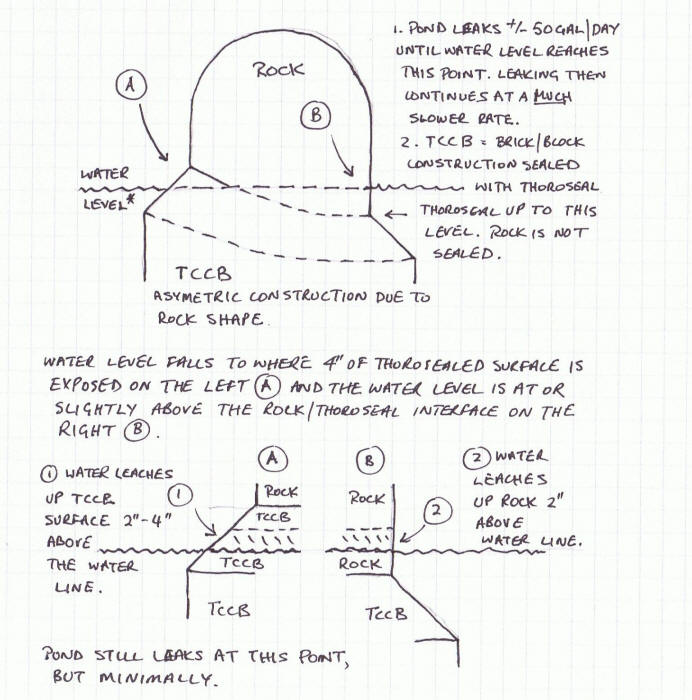 |
Re: Leaky Koi Pond Hi! Bob, <Jack> And
thanks for the prompt reply. Your message is very clear but I
don't think we have the space to line the existing structure
and hide the rock / liner interface with rocks or a ledge etc. So
for now at least we'll try to plug the leak. <The Water Plug
product is a worthy try> But thanks. I did not mention that
there is a waterfall spilling down the rock and there may be some
water loss into the rock by absorption or via fissures. Is there a
clear spray or brushable sealer out there that will not
significantly change the look of the rock but seal it? <There is
not... or to be more fair... All of the ones I have had first, and
reliable second/other hand experience with have not proven
efficacious... I might try dabbing the Water Plug in the crevices
twixt the rocks in the fall> Fish/plant safe of course. The
reason that we are all so paranoid about water out here is that the
only water available infrequently falls out of the sky. Or you can
buy it for about $1 per gallon. <These materials have neither
"body" nor "stretchability"... and surprising
to many folks... rocks do "move"... expand/contract with
temp., moisture/drying...> Thanks again. Jack. <Welcome.
BobF>
Re: Leaky Koi Pond, fixed, now high Alk. from Thoroseal
2/13/09 Thank you for your help earlier. I now have a
leak-proof pond. The ThoroSeal finish was really helpful. <Thoro
does have some very useful products for sure> I am now having
problems controlling the pH which, uncontrolled, will drift up to
>8.5 in 48 hours. <No worries... allow to "soak"
for a few days, drain, perhaps do a dilute acid-wash (see WWM re),
and re-fill> The whole pond is ThoroSealed and I use only rain
water for filling. The rainwater's pH is 7.5. I have nothing
else in the pond likely to affect pH I noted that on the MSDS for
ThoroSeal it says that it is alkaline, but does not say how much.
<Yes... tis the alkalinity in this product that has bolstered
the pH here> Does the alkalinity leech out and finally go away.
<Yes> Is there anything else I can do other than keep adding
acid? <Mmm, time going by...> Thanks. Jack <Please read
here: http://www.wetwebmedia.com/PondSubWebIndex/acidblchpds.htm
and the linked FAQs files above. Bob Fenner> |
"Water Loss", pond 6/10/08 Hello, I got
a question in regards to my 12' X 14' X 4' (deep) Koi pond
with a 4' in length of stream (about 16" wide).&I live in
Southern California, and is it unusual to lose about an inch of water
over 24 hours period given my set up/weather here? <Mmm, such
amounts can be due to "simple" evaporation... given low
humidity, high/er temperature, wind...> Please let me know. I've
looked around the pond trying to detect any possible leak and I've
yet to see any evidence of that. <There are companies who specialize
in detecting such leaks... If this amount of water loss is prohibitive
(we live in San Diego... so know the cost of water) or a concern in
terms of not knowing where it's getting off to... perhaps damaging
someone's property... I would look in the Yellow Pages (see
Swimming Pools... repairs), and call a co. re. Bob Fenner>
| Leaking pond - help! 8/19/07 Hello, <Good
morrow to you> Great posts under "Leaking pond -
help!". I'm thinking the answer to my pond problem is
somewhere to be found... <Perhaps> We have a small (>200
gal) backyard pond (-24" deep) with recirculating water fall.
No fish... just for sound and looks. <Okay> The front pond
wall is stucco over concrete block. The stucco-ed wall had cracks
and loose stucco has been removed. The pond has a back wall of flat
masonry stone. When filled... about 2/3 of the stone wall is under
water and fortunately the stone wall side of the pond does not
leak. (See photos) <I see these...> I have read that a
flexible liner is best for ponds but I do not want to cover the
stone portion. <Mmmm> Is there any way that a liner can be
applied to the bottom and stucco wall only? Leaving back rock wall
exposed, except where the liner is cemented to the corners...
<No, not really. Ideally we would have had this
"conversation" before your actual construction... and
hence you would have used a liner behind the rock work... it would
have functioned as a "skin" a first waterproof barrier...
Neither stucco or "cement" are waterproof...> If a
partial liner covering (1 side wall with a liner) is not possible
then my only option is to resurface the stucco side that failed.
<Mmm... again... at this point, maybe applying a liner over the
existing work, re-applying new stone over this...> A local
"handyman" quoted $475 (labor only) to remove lose
materials and re-surface one wall. That seemed high. <Not to
me... but this would also fail in time...> I read about a
product called Mulasticoat? It appears to be a do-it-yourself
user-friendly product (no special tools, easy to apply). <This
too will likely not last for long...> So... Advice please... Is
it Liner or Re-coat? Do it myself ("average
common-sense-handy") or do I bite-the-bullet and have a
professional do it? Thanks Howard S <IF I were still actually
"in the biz" (instead of just an easy chatter re) I would
definitely ONLY do this job with applying a liner... as if the
existing basin were just a hole... To be sure of integrity. Bob
Fenner> |
|
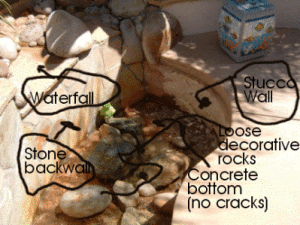 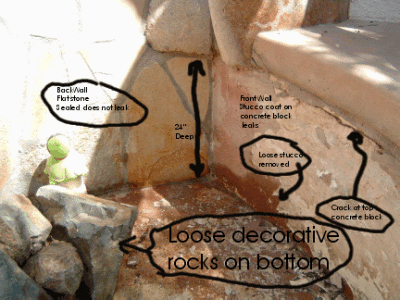
|
Pond Construction problems.
Hello, I am Jim Garrett and a construction management major a Western
Carolina University and doing an internship this summer and a problem
has arisen with a pond and waterfall at a residential site development.
I have monitored the water level and there has been a slow leak. The
pond has no liner but was constructed with a product called Klingstone
400 manufactured by Klingstone Inc. of Waynesville, N. C. This is a
polyurethane product and the landscapers were injecting under this hard
surface plastic with more urethane that reacts with water and expands
to fill the voids that undermined with more leakage. <Mmm, I would
have used a liner... cheaper, more dependable...> We are at a point
of trying to decide what to do about this situation, should we tear it
out and start over with liner. The owner would like to see a 20 year
product. Do you think this can be salvaged? <Possibly... depending
on what the basin/s look like, how much "through-put"
material there already is... if the plumbing can be laid in a new
bottom, you might be able to treat the current construction as
"just a hole"... and re-build over it with a liner...> I
would greatly like to speak with you on the phone. My home # is 828-
and I leave recorder on while at work, and my cell # is 828-. I would
gladly call you back. This project was started back in April 04. We get
water from a nearby river, and right now we are considering bringing
water through a 2" line from a creek approximately 1500 feet for
elevation and to reach the top of the water fall that would add to
volume, present pump is at 135 to 140 GPM. Owner wants more volume for
more visual effect, this waterfall and pond is at the entrance near a
covered bridge that was built across the river. This is to be a grand
entrance for the development in the Appalachian Mountains. If you could
help me in anyway I would sincerely appreciate it. Thank you for you
time. Sincerely, Jim Garrett. <The pumping issue is of course a
separate item... When/if you re-do the basin/s, you might want to
up-size the plumbing or add another two inch ID line... to get the flow
you list... I hope you have a two speed motor... can be rigged with a
timer or maybe a visual switch to turn on to the higher rate for a
time... save some real money in the long haul. Am out at our place in
Hawaii till the end of month... but can/will e-chat with you re this
project if you'd like. Bob Fenner> James Garrett
| Cement pond repair Dear Mr. Fenner, I am a park
ranger for the County of Orange, with responsibility of Arden-The
Helena Modjeska Historic House and Gardens. We have two ponds at
the park, both are historic. Diameter is about 14 ft, depth is
about 2.5 ft. see the attached photos. <I do> One leaks, one
does not. The ponds are historic and on the grounds of a National
Historic Landmark, one of just two in Orange County. For those
reasons, I want to proceed with caution and be as minimally
invasive as possible. <Understood> A previous ranger emptied
the pond to clean it, left it dry for a while in the hot summer
sun, which I believe caused the seal on it to shrink and cause
leaking. After refilling it, it began leaking, a couple inches per
week. Once again, last January, he emptied it, left it dry for a
couple of weeks, and the leaking increased. It has now been empty
since Feb. I have no records of how it was sealed by park staff
prior to 5 years ago, but I do know it was sealed. <Okay>
Some people have recommended using Mulasitcoat, and of course, I
have read the link you provide, suggesting Thoroseal http://www.wetwebmedia.com/PondSubWebIndex/thoroselart.htm
http://wetwebmedia.com/PondSubWebIndex/concrepart.htm.
Others have suggested lining it, then adding a new coat of cement
over the liner. If possible, I would like to avoid such extensive
work, however I realize a quick fix is not always a long term
solution. <Yes> Can you advise me in any way? with
appreciation, Diane Wollenberg, Park Ranger South County Historical
Facilities <It appears you have well-considered your two
principal options here... In the face of fact that this basin is
not leaking very badly, that it is of historical import, I would
first try the coating route... following the manufacturers
installation instructions to a "T". This will likely
involve a thorough cleaning, possibly a bleach and/or acid washing
(an action plan for this is archived on WWM), drying, mixing of the
repair coating with a "mixing bar" and drill motor... and
simply application with thick brushes. I do believe that due to the
age and apparent massiveness of the constructs that this repair may
do the job here. If not, a liner may be retrofitted as you say. One
last concern of mine is to encourage you to pressure test the
plumbing lines (if any) to assure that the leak is not to be found
there instead of the basin. Bob Fenner> |

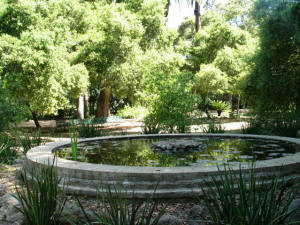
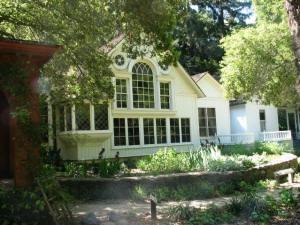 |
Concrete pond leak Hi, <Hello there> I bought a house
with a Koi pond about a year ago. This pond has been leaking and I
think the problem may be getting worse. Without turning on the pump,
the water level drops 1-2 inches a day. <Yikes> When I turned the
pump on, it drops about 5 inches a day. Someone replaced part of the
pipe (the piece that exits the pond connects to the pump) already and I
think it leaks even more after that. I was told by the guy who replaced
it that it was one single piece and therefore the leak can't
possibly be from the new pipe. <Mmm, not so... but in almost all
cases it's not hard to install a temporary plug and pressure test
the line/s. You can have most any pool supply co. do this for you if
you'd like> I have to hire someone else to fix the problem once
and for all, but I don't know whom I can trust. The guy I am
thinking of using told me that I should just reroute/replace all the
pipes and reseal the concrete. <This is one route you could go>
He also said that the pipes used should be a white PVC pipe rather than
a black PVC pipe which is what's currently in place. <Mmm, the
black pipe is likely ABS, not PVC... if the installer used a mix of
these two plastics... or the wrong solvent on them...> Do you agree
with what he is saying? <Possibly... I would like to see a diagram,
a drawing of your basin/s and the actual plumbing schematic... have you
read through my old articles on pond repair posted on
WetWebMedia.com?> What kind of material would you recommend for
resealing/recoating the concrete basin? Or do you have someone that you
can recommend for doing the repair in San Jose, CA? Thank you very
much. Y.T. Lan <I don't know of anyone in your area, but would
interview folks/companies listed in your "Yellow Page"
directories under "garden ponds", "water
features"... Do please read here: http://www.wetwebmedia.com/PondSubWebIndex/concrepart.htm
http://www.wetwebmedia.com/PondSubWebIndex/thoroselart.htm
and the associated FAQs files (links in blue, at top). Study until you
feel comfortable making a decision on how to go here. It may well be
that using the current basin/s as a hole, applying a liner over them,
with wire and concrete, laying new plumbing within this structure... is
your best route for effecting a permanent repair. Bob Fenner>
Concrete Pond In Philly Ladies and Gentlemen, We have 50 year
old pond, concrete, in Philly that the top 1/2 leaks - the pond is 8 x
5 x 2. Apparently, the top half of the sides leak because the bottom,
is fine. What is the best medicine to fix this problem? Thanks, WE
<Best to treat the existing basin as a "hole" and build
another liner-based pond within it. Please read re here: http://wetwebmedia.com/PondSubWebIndex/concrepart.htm
Bob Fenner>
Re: Concrete Pond In Philly Dear Bob, Because of the size and
shape, using a rubber liner within the concrete box would look a little
too chintzy. Thanks. WE <I would use a/the liner with chicken or
stucco wire over it... and shotcrete or hand-pack small grade (3/8 inch
nominal) concrete over/within this. Coloring the material as you wish.
Bob Fenner>
Leaky Pond >We just put in our pond a month ago. We seem
to lose 2 inches of water within 24hrs of filling it. This presents
problem because it brings the water level down past where the skimmer
needs it to be. >>This is definitely a problem, not to mention
wasteful. >The liner is new and we have been tearing it apart trying
to find leak. Do you have any suggestions on trying to find the leak?
Someone said milk but don't understand how that is supposed to
work. >>Me either, how much milk would you use? And, would 1% be
alright, or should you use whole milk? What about cream? This is all
assuming that, should the leak be at the very BOTTOM of the pond, you
have x-ray vision with which to see the milk or milk product leaking
underneath. >Any other suggestions for identifying the water loss?
>>I experienced something similar with our little pre-fab here at
home, and what had happened was that the waterfall outlet had somehow
shifted such that it was allowing water to splash enough so that it was
basically emptying the pond. Other than that, I would be obliged to
empty the pond, and test the liner itself, not a fun proposition.
I'm a bit better at identifying air leaks (especially having a
swimming pool). Marina >Thanks, Debbie Wilkins
Leaking Pond I've a small pond by US standards, but
nothing in the UK is as big as you can do it ! <no... worries,
perhaps we have nothing so charming as a quaint English garden pool
<wink>> There's an upper pond of 600/700 gallons and a
lower pond for the pump with a dam/waterfall - about 9" drop -
dividing the 2. Its 4 years old. The construction is heavy duty
builder's polythene as a liner, with crazy paving type stone set
onto that in a thick mortar bed. Unfortunately I appear to have got one
end of the 'dam' slightly wrong as it leaks slowly there (4
gallons a day I reckon) - the small area of flower bedding there is
meant to be a wet garden anyway so the plants are OK but the loss rate
is higher than I would like. I've got 2 choices I think - the first
is to build more stone into that area to take out the leaking corner,
or alternatively paint the stonework in that area with some sealant.
Can you comment on that - the questions are what sealants are
available, and/or if I was to build in the corner, how can I do it
without disturbing the pond-life (4 Koi, etc), and what would I use as
a mortar. Regards and thanks Rob Graham Edinburgh, Scotland <alas,
my friend... any solution that I can think of does at least require
removal of the livestock for safe repair. I must admit, from what I can
gather you do have a bit of a quandary. The problem is actually a
limitation by the plastic liner. Even set thick, the mortared stone
cannot be trusted to make a long-term seal in either of out climates (I
am in Pennsylvania, USA). Even a gentle shift of the earth from
freeze/thaw will crack the mortar bed in the short term (less than five
years as you have noticed) and require that the liner hold its own.
Unfortunately, the Polyethylene liners are somewhat brittle and not
very long lived even with a sturdy underlayment. I'm afraid that I
cannot offer you a long term solution short of reconstructing the pond
with a thick butyl rubber liner and sturdy underlayment. Assuming that
you can find the leak, flexible sealants will only work for 6 months to
2 years at best. Epoxies require that the painted/sealed
vessel/substrate is perfectly still/does not shift. Quite frankly, the
least expensive and least laborious solution would be to temporarily
remove the livestock, drain the pond, drop a new liner in on top(!) and
dress the top edge as necessary/desired. It is better than gutting the
pond for reconstruction or having to repair it three times in five
years more. Best regards, Anthony>
 |
Aquatic Gardens
Ponds, Streams, Waterfalls
& Fountains:
Volume 1. Design & Construction
Volume 2. Maintenance, Stocking, Examples
V. 1
Print and
eBook on Amazon
V. 2
Print and
eBook on Amazon
by Robert (Bob) Fenner |
 |
|
|

